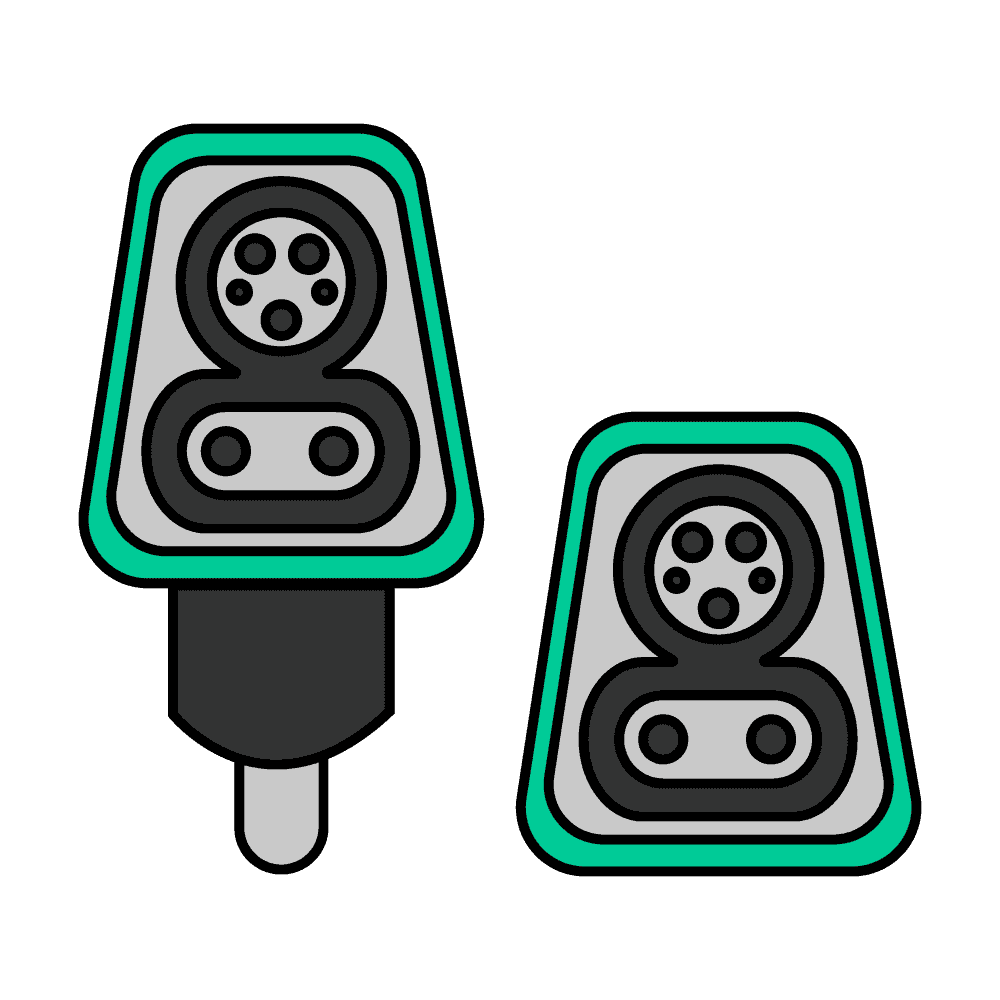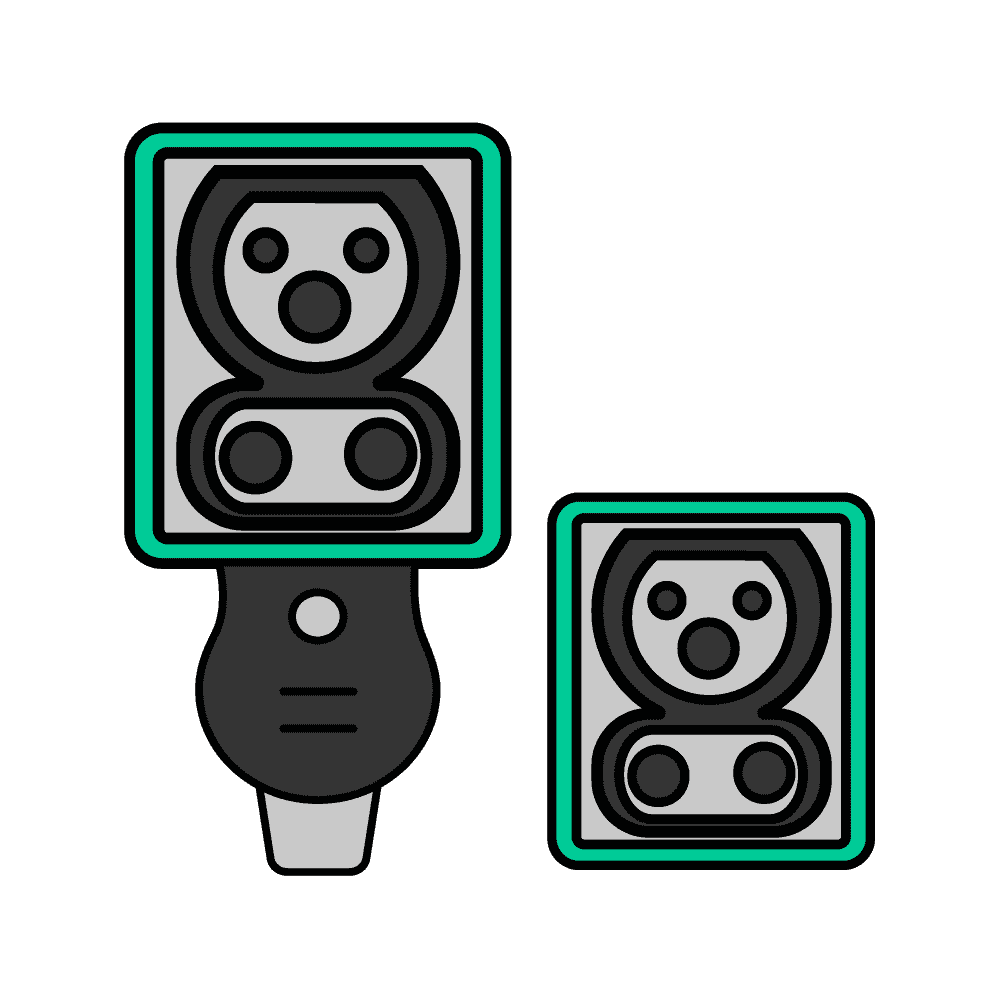Similar to how cell phone manufacturers have different cable types, the plug types for electric vehicles also vary and can lead to unexpected surprises if not taken into account. Choosing the right EV and the right plug types will reduce the anxiety that some feel when thinking about switching to electric. There are future-proof versions and some versions are slowly being phased out. Find below the basics every EV owner should know about cables and plug types.
Different types of plugs exist, some for alternating current (AC), and some for direct current (DC).
What’s the difference between AC and DC charging?
Batteries can only be charged with direct current (DC). Regular wall connection delivers alternating current (AC). Every EV has an onboard inverter to convert AC current to DC, but they have their technical limits. For example, an average European-manufactured vehicle has an onboard charger (inverter) capable of 7kW or 11kW charging. Most public AC chargers can deliver 22kW, but cars can accept only as much as their onboard charger allows. DC charging bypasses the onboard charger and the power is directed directly to the battery. That’s why DC charging can deliver 50kW and more.
The most common plug types for electric cars
Several types of electric car charging plugs exist, please find below the most common:
- Type 1 (SAE J1772)
- Type 2 (IEC 62196)
- Combine Charging Standard (CCS)
- ChaDeMo
- Tesla connector
Depending on your geographical location or your vehicle model, most people use the following standards:
- Europe: Type 2 and CCS
- North America: Type 1 and CCS
- Tesla Model S and Model X owners in North America: Tesla connector and/or a CCS or ChaDeMo adaptor
- Japanese manufactured vehicle owners: ChaDeMo
Let’s start with AC charging plugs and sockets.
AC charging plugs and sockets
Depending on the cable, charger, or the limitations of the vehicle’s onboard charger, the AC connector can deliver anywhere between 2 to 22kW which is usually enough for most home or office charging scenarios. AC charging connectors are divided into 2 versions:
Type 1 (SAE J1772)

Type 1 is also known as a J plug. It can deliver up to 7kW of power and is limited to single-phase charging with a maximum voltage rating of 120V.
Type 2 (IEC 62196)

Also known as “mennekes” in reference to the company that originated the design. Unlike the Type 1 connector, the Type 2 connector can support 3-phase charging. This means that this type has 2 additional wires which increase the maximum power to 22kW. Most vehicles that use Type 2 connectors today can charge with a maximum power of 11kW.
Charging from the wall socket with a dedicated cable
Most electric vehicles can be plugged straight into your regular wall socket with a dedicated cable that usually comes with a car (also known as “Level 1” charger”). This is the slowest way to charge and it can take more than 24 hours to get a full charge with some car types. Using a regular wall socket is potentially dangerous since there is a chance of overheating, which has been the cause of domestic fires in the past. Therefore, this method is not recommended.
Charging from NEMA 14-50P socket (the US only)
Also known as a “level 2 charger” NEMA 14-50P connector is a more powerful version of the standard American wall connector. It was originally designed for electric cookers but it is commonly used for EV charging nowadays.
Adaptor cables (AC only)
Installing a charger with a fixed plug denies access to it for vehicles that would require a different plug. That is why some public charging locations do not provide the cable or the “link” between the charger and an AC charger. Instead, users use their own adaptor cable which may or may not come with the vehicle.
Some car models, like Audi e-tron and Porche Taycan have Type 2 plugs available on both sides of the vehicle making charging more convenient. Certainly would not want a dusty cable running over your vehicle and ruining the paint when the charger happens to be on the opposite side of the vehicle.
DC charging plugs and sockets
The Combined Charging Standard (CCS)
The CCS may be the only DC standard you need to know. The majority of automotive OEMs have switched or are switching to this standard.
CCS covers two versions. The American version (Combo 1) and the European version (Combo 2):


Note that the upper portion is exactly the same as the Type 1 or the Type 2 plug. This is where its name comes from – it combines the AC charging connector with two high-power DC pins.
CCS standard was developed by a consortium of European and American automotive manufacturers to standardize DC charging plugs across different car manufacturers. Very much like the Tesla Supercharger network – CCS enables long cross-continental traveling as well as local commuting.
CCS is the standard DC plug type for most new electric vehicles, with the exception of Tesla Model S, Model X, and Nissan Leaf. When buying a new vehicle, CCS should be preferred. Even Tesla and Nissan use CCS with their newer models. The plug itself is quite impressive: it can deliver up to 350kW of power when water-cooled.
ChaDeMo

Also called the “Japanese standard”. Even though it is a very popular plug type, ChaDeMo is slowly being phased out. Even Nissan, who has used this standard most widely, is switching to CCS with their newer mass-market model Ariya. The biggest advantage of this plug type is the possibility to support bi-directional charging. Nissan Leaf has been used so far to power medical equipment during natural catastrophes in Japan during a power outage. Despite this advantage, the maximum power of 62kW is not future-proof. Engineers are working on increasing that to 400kW, but by the time that happens, CCS has taken over most of Europe and North America. Very likely newer versions of CCS will support bi-directional charging as well.
Tesla connector

Unless you own a Tesla Model S or Tesla Model X, then you would never need to know about this connector type. It has been one of the most innovative connector types in the past, combining both AC charging and DC charging into one socket and plug. For newer models like Model 3 and Model Y CCS standards will be used. Therefore it is likely that the Tesla connector type may be slowly phased out.
Conclusion:
To summarize, different types of plugs exist. Type 1 and type 2 plugs for alternating current. CCS, ChaDemo, and Tesla connector for direct current. We hope you find this overview of all relevant plug types for electric cars useful. If you have any further questions, feel free to contact us at contact@homechargingstations.com.